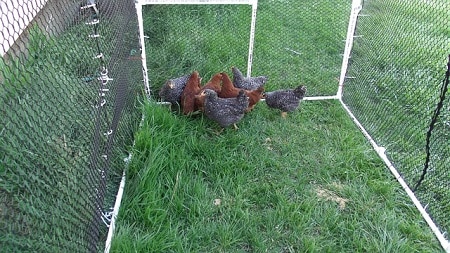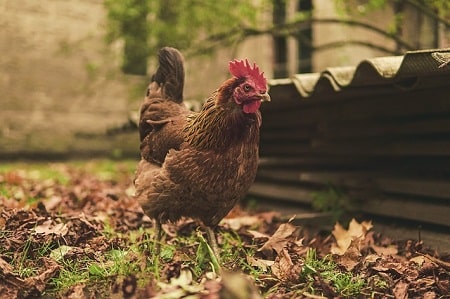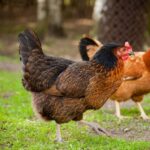Does a chicken run need a roof? Yes, a chicken run does need a roof of some kind. The run is their outdoor space, but it needs to be enclosed for safety reasons. Both to stop chickens getting out and predators getting in.
If you’re planning on adding a new chicken run or modifying your existing run, here is everything you need to know about what makes a good run for your chickens:
Table of Contents
Reasons Why You Should Cover Your Chicken Run

As I touched on above, there are a few reasons why you should at least cover your run with some kind of material:
To stop predators - You might have no known predators where you live, and that’s great. But with large birds like owls are known to kill chickens, and foxes are so sly that most of the time no one knows they're in the neighborhood. It's better to be safe than sorry.
To stop escapes - We’ve all seen the movie Chicken Run, right? Well, real life is nothing like that, but a chicken can still clear a 4 ft fence if they really wanted to. Some breeds, like the California White, can clear even higher fences.
Protect against the elements - Being as the run area is “outside” for most chickens, they are exposed to the elements. In the summer months, they’ll need shade to cool off under and in the winter months adequate cover from the rain.
Taking into account all of the above, this is why a lot of runs have a mesh roof with a waterproof sheet that pulls over when needed. This provides the best of both worlds.
How High Does a Chicken Run Need to Be?
The most important consideration when deciding how tall to make a run is whether or not you’ll be going in there, which you likely will.
This is the main reason why most runs are 6 ft or so tall. They are made easily accessible by the door for us to go in and clean them out.
If we never needed to go into the run it would only need to be a foot or so higher than a chicken. It’s more important that it has enough floor space to accommodate all your chickens. Chickens are very mobile walking around, they don’t try to fly very often.
Best Chicken Coop Roof Material?

You have a few options when it comes to choosing a material to make your roof out of. Some of the most common options are:
Corrugated metal - Metal sheeting is always one of the easier and less expensive options, but it’s also the ugliest looking (in my opinion) and not the best for protection against the weather.
It makes a racket when it rains, and becomes hot in the summer, although it does offer good protection.
Onduline - Onduline looks like corrugated metal but is a stronger, more durable, and lighter plastic material.
It’s better than metal because it doesn’t rust or rot over time, is more flexible and easier to work with, and you can get a shade that lets some light through while blocking harmful U.V. rays.
Waterproof sheeting - If you buy a metal run that pops up it will almost certainly be made from a metal cage with a waterproof cover like a tarp.
These aren’t permanent like the roofing I’ve already mentioned, but it’s really easy to just pull it over part of the roof when needed.
Wood/Felt - Coops are typically made from wood. Sometimes the run will be an extension of the coop and have a wooden roof covered in felt.
This usually looks the best and will do just fine. It just means you can pull it back to let more sun in if you need to. If you don’t let enough sun and warmth in you end up with a muddy run area.
Don't Forget to Make a Space for a Dust Bath
You can’t always choose where your flock will make their dust bath, but it will almost always be in their run.
In case you were not aware of this, chickens bathe in the dirt. That’s right, not water, but dirt.
There are quite a few animals that do this, and it’s actually an effective way of shaking off dirt and debris, external parasites like lice, and removing excess oil from their feathers.
All they need is an area with loose dirt so they can dig out a bowl-shaped hole to roll around in. Free-range chickens often end up doing this exactly where you don’t want them too, so it’s a bonus when it’s in their coop or run.
Most soils are fine as long as the top layer is loose. You can add some sand to an area within their run, however, and this is often enough to entice them to use that area.
I’m mentioning this because it might affect your roof coverage. The area they create a dust bath in needs to be dry.
How to Build a Chicken Run With a Roof
If you want to see a coop being built - complete with a roof - you’ll find this video helpful.
She makes the roof by using a piece of plywood and covering it with shingles. The result is a waterproof, neat looking roof. It’s a tall coop, so it’s still letting plenty of natural light in.
Take a look and see what you think:
In Summary
Hopefully, you know understand why you should always have a roof on your chicken run and what the best materials and ways to build one are.
If your run is long enough, the best option is to always go half and half.
By this, I mean cover half with a roof that will block the sun and provide some shade for your flock. The other half should be secure, so covered with a mesh or metal cage bars, but letting sunlight in.
Sunlight is important to chickens, and it’s also important to keep the floor of the run from becoming a soggy marshland.
It all depends on what the weather is like where you live and what kinds of threats are present from predators. Your chicken’s safety should always come first.




